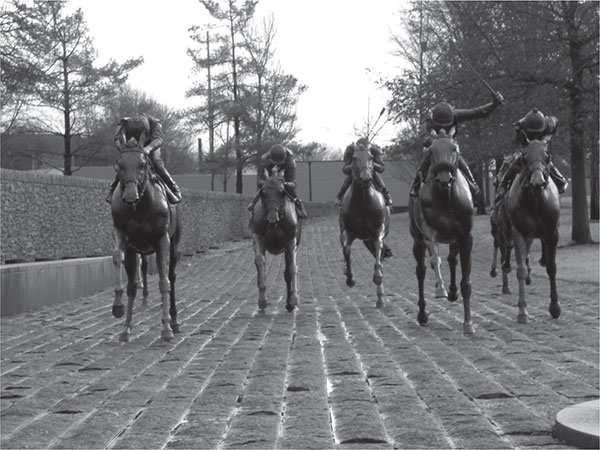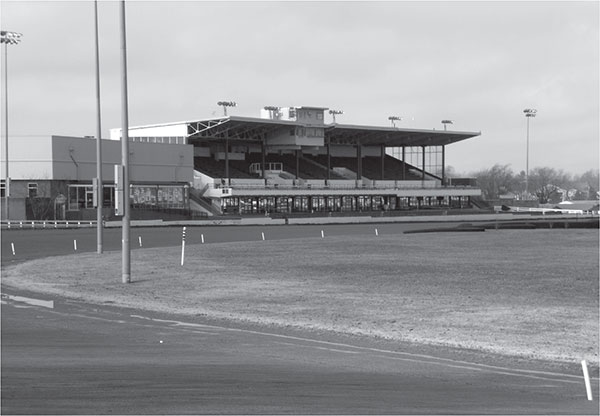
THE HISTORY OF THE HORSE
Before there can be a history of horse racing, there must first be a horse to race. In Kentucky, at least, children were taught in elementary school that horses were first brought to the Americas by the Spanish conquistadors in the fifteenth century, and that escaped or abandoned horses went wild and spread into North America, where the native Indians adapted them to use.
While the latter part of that history is true, the Spanish did not first introduce horses here. In fact, the earliest animal that would evolve into the modern horse originated in North America.1
The first little horse was Hyracotherium or Eohippus (“dawn horse”), which lived fifty-five to forty-five million years ago in central North America. It stood between ten and seventeen inches tall at the shoulder with four toes on its front legs and three toes on its hind legs. This configuration helped keep Eohippus from sinking into the swampy condition of the land at that time and evade predators.2 Evidence of this animal has been found in Utah and Wyoming.3
Little Eohippus evolved into Mesohippus, now growing up to forty inches tall at the shoulder and possessing longer legs.4 It lived roughly thirty-seven to thirty-two million years ago. Changes in the climate and geography drove the physical changes in this early horse as the swamps had turned into soft ground. The outside toes were smaller, while the middle toe became larger.5
Next came Pliohippus or Equus, in the Pleistocene epoch; it would be recognized today as a horse.6 This period was twelve to six million years ago. The flanking toes had further receded and the center toe had evolved into a hoof. Teeth and legs resemble the modern horse, and Equus had evolved into a faster runner. It spread into South America and across the land bridge at the Bering Strait into Asia, Europe and eventually Africa.7
For reasons not yet known, Equus became extinct in the Americas between eight thousand and ten thousand years ago.8
Equus evolved into the modern horse in Central Asia. There, horses changed in use from sources of food to transportation, both pulling loads and as personal conveyance.9
Finally, the horse came full circle and was returned to the Americas with Hernán Cortéz on his excursion to Mexico in 1519.10 The first recorded horse brought to colonial America by the English was to Jamestown in 1610, three years after settlement. By 1620, horses were fairly common in the Virginia colony, although used primarily as working beasts, not for pleasure or sport.11
Whether the first horse race started with a wager, a challenge or an inspired flight from danger is lost in the mists of history. Horse racing is one of the oldest sports, and its core concept has never changed: the horse that gets to the finish first wins!12
What is clear is that once the basic tenets of how to break, train and ride a horse were worked out, military leaders were quick to take advantage of the escalation in weapons delivery the horse produced. The Assyrians, Egyptians, Mongols and other ancient peoples used chariots in battle. Chariot races were run in the Greek Olympics in 610 BC and are featured in Homer’s Illiad.13 What today is called a “parting shot,” a verbal insult cast over the shoulder as the speaker leaves a room or stage, has its origin in a military tactic of the Parthians, an ancient Iranian culture. They perfected the shooting of an arrow at full gallop while turned around on the back of the horse. An enemy would think the Parthian cavalry was retreating and charge, only to meet a wall of arrows as the horsemen attacked “in reverse.” This required tremendous skill on the part of the rider, as the stirrup had not been invented and the rider commanded his horse solely with knee pressure while his head and hands were occupied shooting his bow.14
The Romans, of course, followed, and many nobles had large stables of horses.15 Romans raced both chariots and individually mounted horses.16 Even the modern sport of eventing, commonly called a Three Day Event, arose from military use of the horse in battle in the nineteenth century.17 The first day is dressage, a kind of equine ballet in which rider and horse perform a series of movements, lead, gait and pace changes, and circles with the barest evident movement on the part of the rider. This shows the ability of the rider to command his or her horse. The second (and sometimes a third) day is a timed run over miles of pasture, jumps, streams, roads and tracks to show the stamina of horse and rider fit for battle. Finally, the last day is stadium jumping inside an area, with a series of jumps to demonstrate that even after a “battle,” horse and rider are able to perform. One of the world’s premier Three Day Events is the Land Rover, formerly the Rolex, at the Kentucky Horse Park in Lexington, Kentucky.18

Thoroughbred Park. downtown Lexington, Kentucky. Photograph by author.
Owning, training and racing horses, and training riders beyond military and farm use began when English knights returned from the Crusades with fast Arab horses in the twelfth century.19 During the reign of King Richard (1189–99), the first recorded purse was offered for a race of three miles. The horses were ridden by knights. Successor kings had large stud farms for breeding and held race meets. Charles I owned 139 stallions.20
The return of the Stuarts to the throne in 1660 with Charles II marked what is generally considered the beginnings of the modern era of horse racing. He was the first king to race horses under his own name.21 Finally, during Queen Anne’s time (1702–14), the practice of two-horse match races gave way to a field of several horses and public wagering. Racecourses were established around England, each offering large purses to attract the fastest horses. Enough money was in play that it became possible to own, breed and race horses as a business. In 1750, the English Jockey Club was organized at Newmarket to make the rules and regulate English racing.22 Finally, the English Stud Book was started in 1791 to keep track of the breeding ancestry and progeny of thoroughbreds.23 After a few years, it was updated annually. According to the Encyclopedia Britannica, all thoroughbreds are the progeny of three Arabian stallions—Darley Arabian, Godolphin Barb and the Byerly Turk— bred to forty-three “royal mares” imported by Charles II.24

Red Mile Racecourse. Photograph by author.
In contrast to the long English history of thoroughbred racing, trotting or harness racing is said to have originated in North America. The New York Times in an 1897 article attributed it to early Dutch settlers. Anyone with a two-wheeled cart and a horse could race. By 1879, the term “standardbred”25 had come to apply to this breed, and a parallel system of racetracks was developed for harness racing, including the famous Red Mile in Lexington, Kentucky, named for the red clay in its track surface.26